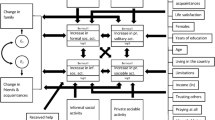Abstract
This study tested the hypothesis that time spent on social activities (i.e., in direct interaction with others) and time spent in social contexts (i.e., while others are present) is associated with survival in persons aged 70 and older. An observational study with mortality follow-ups was carried out in the former West Berlin, Germany (Berlin Aging Study). The sample was stratified by age and sex, and consisted of 473 persons aged 70 to 103 years. Social activity and social context measures were assessed in 1990–1993 by structured interviews in the participants’ homes. Cox regression was used to model survival from time of interview. The main outcome measure was survival on 1 August 2003. Time spent on social activities was revealed as a predictor of survival only in analyses that did not control for confounding factors. In contrast, time spent in context “with friends” was significantly related to increased survival (relative risk=0.76, 95% confidence interval 0.59 to 0.99) even after several confounding factors were controlled for. This study suggests that time spent with friends affords a survival advantage among older adults, above and beyond the effects of other leisure activities. Future research on social participation and survival may benefit from an examination of the interaction between activity content and social context.

Similar content being viewed by others
References
Allison PD (1995) Survival analysis using the SAS system: a practical guide. SAS Institute, Cary, NC
Baltes PB, Mayer KU (eds) (1999) The Berlin Aging Study: aging from 70 to 100. Cambridge University Press, New York
Baltes MM, Maas I, Wilms H-U, Borchelt M, Little T (1999) Everyday competence in old and very old age: theoretical considerations and empirical findings. In: Baltes PB, Mayer KU (eds) The Berlin Aging Study: aging from 70 to 100. Cambridge University Press, New York, pp 384–402
Buunk BP, Schaufeli WB (2000) Reciprocity in interpersonal relationships: an evolutionary perspective on its importance for health and well-being. In: Stroebe W, Hewstone M (eds) European review of social psychology, vol 10. Wiley, Chichester, pp 259–291
Cantor N, Sanderson CA (1999) Life task participation and well-being: the importance of taking part in daily life. In: Kahneman D, Diener E (eds) Well-being: the foundations of hedonic psychology. Russell Sage Foundation, New York, pp 230–243
Cohen J (1960) A coefficient of agreement for nominal scales. Educ Psychol Measure 20:37–46
Cox DR (1972) Regression models and life tables. J R Stat Soc B34:187–220
Glass TA, Mendes de Leon C, Marottoli RA, Berkman LF (1999) Population based study of social and productive activities as predictors of survival among elderly Americans. Br Med J 319:478–483
Hendricks CD, Hendricks J (1998) Aging in mass society: myths and realities. Addison Wesley, Reading, MA
Herzog AR, Ofstedal MB, Wheeler LM (2002) Social engagement and its relationship to health. Clin Geriatr Med 18:593–609
House JS, Robbins C, Metzner HL (1982) The association of social relationships and activities with mortality: prospective evidence from the Tecumseh Community Health Study. Am J Epidemiol 116(1):123–40
Johnson CL, Barer BM (1997) Life beyond 85 years: the aura of survivorship. Springer, Berlin Heidelberg New York
Klumb PL, Baltes MM (1999a) Time use of old and very old Berliners: productive and consumptive activities as functions of resources. J Gerontol Soc Sci 54B:S271–S278
Klumb PL, Baltes MM (1999b) Validity of retrospective time-use reports in old age. Appl Cogn Psychol 13(6):527–539
Klumb PL, Maier H (2002) Daily activities and survival at older ages. Max Planck Institute for Demographic Research, Rostock, Germany, MPIDR Work Pap WP-2002-041 (http://www.demogr.mpg.de/papers/working/wp-2002–041.pdf)
Kraemer HC, Kazdin AE, Offord DR, Kessler RC, Jensen PS, Kupfer DJ (1997) Coming to terms with the terms of risk. Arch Gen Psychiatr 54:337–343
Kruse A, Wahl H-W (1999) Soziale Beziehungen. Z Gerontol Geriatr 32:333–347
Lemon BW, Bengtson VL, Peterson JA (1972) An exploration of the activity theory of aging: activity types and life satisfaction among in-movers to a retirement community. J Gerontol 27:511–523
Lennartsson C, Silverstein M (2001) Does engagement with life enhance survival of elderly people in Sweden? The role of social and leisure activities. J Gerontol Soc Sci 25:S335–S342
Lindenberger U, Gilberg R, Little T, Nuthmann R, Pötter U, Baltes PB (1999) Sample selectivity and generalizability of results of the Berlin Aging Study. In: Baltes PB, Mayer KU (eds) The Berlin Aging Study: aging from 70 to 100. Cambridge University Press, New York, pp 56–82
Longino CF Jr, Kart CS (1982) Explicating activity theory: a formal replication. J Gerontol 37(6):713–722
McEwen BS (1998) Protective and damaging effects of stress mediators. New Engl J Med 338:171–179
Menec VH (2003) The relation between everyday activities and successful aging: a 6-year longitudinal study. J Gerontol Ser B Psychol Sci Soc Sci 58(2):74–82
Mirowsky J, Ross CE (1998) Education, personal control, lifestyle and health—a human capital hypothesis. Res Aging 20:415–449
Moss MS, Lawton MP (1982) Time budgets of older people: a window on four lifestyles. J Gerontol 37:115–123
Nakanishi N, Tatara K (2000) Correlates and prognosis in relation to participation in social activities among older people living in a community in Osaka, Japan. J Clin Geropsychol 6(4):299–307
Nakanishi N, Fukuda H, Tatara K (2003) Changes in psychosocial conditions and eventual mortality in community-residing elderly people. J Epidemiol 13:72–79
Pinquart M, Sörensen S (2000) Influences of socioeconomic status, social network, and competence on subjective well-being in later life: a meta-analysis. Psychol Aging 15:187–224
Reid M (1934) Economics of household production. Wiley, New York
Reis HT, Sheldon KM, Gable SL, Roscoe J, Ryan RM (2000) Daily well-being: the role of autonomy, competence, and relatedness. Pers Soc Psychol Bull 26(4):419–435
Rowe JW, Kahn RL (1998) Successful aging. Pantheon Books, New York
Sapolsky RM (1993) Potential behavioral modification of glucocorticoid damage to the hippocampus. Behav Brain Res 57:175–182
Schooler C, Mulatu MS (2001) The reciprocal effects of leisure time activities and intellectual functioning in older people: a longitudinal analysis. Psychol Aging 16(3):466–482
Seeman TE (2000) Health promoting effects of friends and family on health outcomes in older adults. Am J Health Promot 14(6):361–370
Seeman TE, McEwen BS (1996) Impact of social environment characteristics on neuroendocrine regulation. Psychosom Med 58:459–471
Seeman TE, Berkman LF, Blazer D, Rowe J (1994) Social ties and support and neuroendocrine function. MacArthur Studies Of Successful Aging. Ann Behav Med 16:95–106
Seeman TE, Singer BH, Ryff CD, Dienberg Love G, Levy-Storms L (2002) Social relationships, gender, and allostatic load across two age cohorts. Psychosom Med 64(3):395–406
Steinbach U (1992) Social networks, institutionalization and mortality among elderly people in the United States. J Gerontol Soc Sci 47:S183–S190
Thoits PA (1983) Multiple identities and psychological well-being: a reformulation and test of the social isolation hypothesis. Am Sociol Rev 48:174–187
Tinetti ME (1986) A performance-orientated assessment of mobility problems in elderly patients. J Am Geriatr Soc 34:119–126
Walter-Ginzburg A, Blumstein T, Chetrit A, Modan B (2002) Social factors and mortality in the old-old in Israel: the CALAS study. J Gerontol Ser B Psychol Sci Soc Sci 57(5):308–318
Welin L, Larsson B, Svardsudd K, Tibblin B, Tibblin G (1992) Social network and activities in relation to mortality from cardiovascular diseases, cancer and other causes: a 12 year follow up of the study of men born in 1913 and 1923. J Epidemiol Community Health 46(2):127–132
Wilson RS, de Leon CFM, Barnes LL, Schneider JA, Bienias JL, Evans DA, Bennett DA (2002) Participation in cognitively stimulating activities and risk of Alzheimer disease. J Am Med Assoc 287:742–748
Acknowledgements
The present research was conducted within the context of the Berlin Aging Study (BASE), which is co-chaired by Paul B. Baltes and Karl Ulrich Mayer. BASE has been financially supported by several organizations, including the German Federal Ministry for Research and Technology (1989–1991, 13 TA 011+13 TA 011/A) and the German Federal Ministry for Family, Senior Citizens, Women, and Youth (1992–1998, 314-1722-102/9+314-1722-102/9a). We thank Peter Bath, Dorly Deeg, and Hans-Werner Wahl for their helpful comments on earlier drafts. An earlier version of this paper was presented at the 56th Annual Scientific Meeting of the Gerontological Society of America (GSA) in San Diego, CA, USA, 21–25 November 2003.
Author information
Authors and Affiliations
Corresponding author
Rights and permissions
About this article
Cite this article
Maier, H., Klumb, P.L. Social participation and survival at older ages: is the effect driven by activity content or context?. Eur J Ageing 2, 31–39 (2005). https://doi.org/10.1007/s10433-005-0018-5
Published:
Issue Date:
DOI: https://doi.org/10.1007/s10433-005-0018-5




